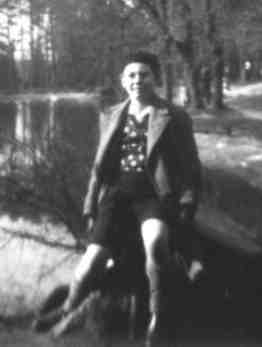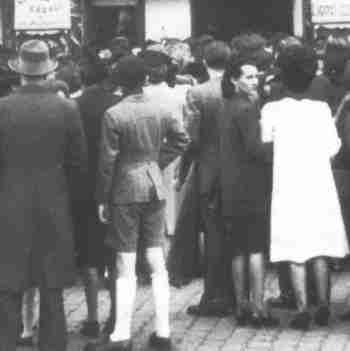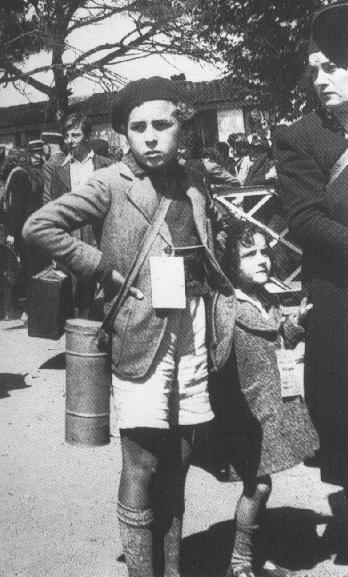
Figure 1.--This older French boys wears a beret with a sweater and short pants for an outing with his parents. It is winter and he is wearing golves.


Figure 1.--This older French boys wears a beret with a sweater and short pants for an outing with his parents. It is winter and he is wearing golves. |
The beret has to be the most versitile head gear in history. What
other head gear has been wore by little boys and girls, elite soldiers,
scruffy Cuban revolutionariers, boy and girl scouts, shepards, a
president's nemesis, and many others more. It is esentially a visorless
cap--but the simple design can be worn for a multiplicity of different
looks. While men, boys, women, and girls have worn berets in many
different countries, no country is more associated with the beret than
France. The image of the Frenchman brining home his baguete dressed in a beret, howeverm has become a historic image. The modern French yupie is more likely to be seen in an Asian-made baseball cap. Note: Despite its common usuage in France, I have been able to find very little information so far about its usage in France. Even some of the French contributors to HBC have very few details to offer about berets.
The beret is a soft round visorless cap. It has virtually no adornment.
While there is no pom at the stop, many do have a small siggule of cloth.
Scout berets often come with a later head band, but regular berets are all
wool. The better ones may have a silk lining. It can be worn in many
different ways for a wide variety of looks from adventurous to sedate. French boys have generally worn it pulled down or occasionally like a pancake, and not commonly at an angle like the military wore it. Although I have no historical information confirming this, an assessment of available historical images show that most boys wore it pulled down on their heads. Occasionally a well dressed teenager might wear is beret a little rakishly, but this was not common. Some of the early French Scout groups wore large floppy berets, but this was not the common style worn by French boys. The only modern French boys wearing berets are Scouts. These now wear their berets much differently. Rarely is it pulled down on their heads, but neither have they adopted the military looked worn at an angle.
The berets worn by French boys almost always seem to be black or dark
blue berets. I have not noted relatively few light-colored berets.
Perhaps the dark colored berets don't show dirt or heavy usage as much.
Perticularly stylishly dressed boys, however, might have a beret made out
of the same material as there suit. This was not common, but as the
photographs here show, it did occur. The vast majority of photographs
available on France, however, suggest it was almost always a black
beret.
The beret is so old no one can be sure of its basic history, but it seems to have originated in France, "beret" being a French word. Yet, like
many words, beret actually comes from a Latin word, in this case "birretum",
which means "cap". And basically, "cap" is exactly what a beret is. A
floppy cap.
We are not completely sure about Gender conventions concerning berets in France. This is a little difficult to assess because most school portraits are posed without headwear. A few available French school portraits show the boys wearing berets, but not the girls. A good example is the French boys in a Casablanca school during 1929. A complication here is the tam, similar but larger than the beret. We are not sure how common tams were in France. We see some private schools adopting the beret as part of girl's school uniform, this became especially prevalent after World War II when fewer boys were wearing berets. As far as we can tell, there were only a few such schools. Berets were also adopted by some youth groups, but more by boys' groups than girls.
Historical accounts show that the beret was worn by European nobility
as early as the 14th Century. I do not have
any details yet on the origin of the beret in France. It does not
appear to have been commonly worn by boys or men during the
Revolutionary or Napoleonic era of the late 18th and early 19th
Centuries.
Berets were being worn school boys and laborers by the
late 19th Century. I am not sure precisely when boys began wearing them,
but it might have been the 1870s when the new Third Republic Government
introduced school smocks. At the time it was strictly for boys
and girls did not wear them.
The beret was commonly worn by French boys through the first half of the 20th Century. Boys of all ages wore them. One French contributor to HBC suggests that the popularity of
berets for boys increased greatly in the 1920s. They were commonly worn in the 1930s and early 40s. Their popularity as a boys' cap, however, declined quickly after World War II. It is notable how quickly this foremerly popular style disappeared. I am not sure why this
occurred. The beret was still commonly worn in France at the time of World War II. A French contributor reports that the beret began disappearing after the War in the late 1940s. The beret largely disappeared in the in the 1950s. The American influence of caps, young people felt that berets were not very stylish. The evolution of the affluebnt middle class was another factor. Modern French adults saw the beret as unsophisticated peasant clothing--the Frenchman with his beret and baguette became a characture. Another French reader who had fashionablle parents tells HBC that his parents saw the beret as a old-fashioned cap for unfashionable country children. Beret making in France which was once a thriving indistry had dwinled to only 2 companies in the late 1990s. The two small companies are very traditional, using methods and equipment over 100 years old.
The beret has to be the most versital headwar ever. It has been
worn by school boys and girls, little boys and girls, boy and girl
scouts, shepards, soldiers including Green Berets and paratroopers,
Cuban revolutionaries, and many more. No country is more associated
with berets than France. In France it was traditionally
a boy's or man's cap, and the image of a French boy on his way to
school in a beret amd smock is a firmly established, but now
historical image in France. Since World War II girls and women have
begun wearing the beret as well. Perhaps this may be part of the
reason that boys stopped wearing them.

Figure 4.--French school boys continued wearing berets and smocks throughout the 1920s and 30s. |
The beret is traditionally associated with French schooboys much as
school smocks. I do not have precise details, French schoolboys may have began wearing berets. They were certainly being worn by the late 19th century. One French HBC contributor, however, believes that berets appeared earlier. When ever they appeared, they were very commonly worn by school boys in the 1920s and continued to be commnly worn until after World War II (1939-45). While many school portraits show the children without headwear, enough exist to show that the beret was very common in the inter-war era. A good example is the French boys in a Casablanca school in 1929. While we see boys wearing berets in the 1930s and early 40s, they seem to have very rapidly disappeared after World War II. Just why such a rapid change occurred we are not sure.
Actually it was not just schoolboys
who wore berets. It was in the first half of the 20th Century the
trade mark of the working class and during World War II, the Resistance.
It is now not commonly worn in France, although men but rarely boys can
occasionally been seen wearing it.
The beret in France appears to have been considered an esentially
iformal cap for boys. Througout the late 19th and early 20th Century
boys appear to have worn them with casual clothes. Boys in
smocks, however, commonly wore berets. Not only with their school
smocks, but also with other smocks they may have played in at home.

Figure 5.--This French boy wearing a beret with his short pants suit is waiting to see a movie. |
I do not believe it was considered appropriate for dress up occasions.
Fashion plates in the late 19th and early 20th Centuries show French boys
wearing a variety of dressup clothes. Sailor hats and caps were
especially popular, but berets were rarely worn with dress clothes.
Perhaps because the beret was commonly worn by workers, it was not considered sufficently formal for dress occasions. The conventions for wearing a beret appear to have changed after World War I (1914-18), for unknown reasons. Boys of all ages, including older boys began wearing berets with their dress suits. This was perhaps because the styles commonly worn by boys such as sailor hats and caps were going out of style. Thus in the 1920s and 30s it was commoin to see quite old boys up to 15 or 16 years of age, sometimes even older boys,
in short pants suits and wearing berets. It is rarer, however, to see
boys in long pants suits wearing berets. Boys, especially those in short
pants suits, continued to commonly wear berets until the late 1940s when
berets started going out of style.
French Scours wore berets early on, but it was not until after World
War II that Scouts in many other countries began wearing them. There
are several different French Scout associations, most have adopted black
or dark blue berets. Unlike most other countries where Scouts wore berets,
in France some of the Cubs also wore berets instead of the traditional
peaked caps.
A proper beret is always made out of a wool flannel material

Figure 6.--French boys still commonly wore berets in the early 1940s. This photograph was taken in May 1940 as the German Army was over running France. The box contains his gas mask. |
Several conventions are notable with the French boys wearing berets:
Boys wearing berets always seem to have had short hair. Many mothers
in the 19th Century especially liked to let their sons' hair grow long.
All the images I have seen, however, of French boys in berets show the
boys in short hair. This is primarily because French boys did not
used to wear berets until they began school and most boys had their
long hair or curls cut before they began school. Although some boys wearing a beret may need a hair cut, they do not normally seem to have had long hair.
Berets for many years were for older boys of school age and not for
younger boys in dress clothes. After World War I, boys including older
boys began wearing berets with their dress suits. It was primarily the
boys wearing shot pants suits that wore the berets. Aparently many boys who wore long pants suits wanted more adult looking caps and hats. available photographs, however, suggest that many boys with long pants suits also wore berets. Younger boys might wear smocks, but it was mostly considered informal wear. Boys wearing smocks around the home, for example, might wear berets.
Berets are worn in several different ways. We see photographs of French and other boys wearing berets differently, even boys in the same photograph. We are unsure why there are so many differences. Apparently there was no accepted convention as to how the beret should be worn. A good example is the French boys in a Casablanca school in 1929. The way the beret is worn can give radically different images to the boys wearing it.
The beret was worn throughout France. It seems to have been especially popular among the Basques in the south.
The finest beret in the world is the French Basque-made Hoquy, made by the Hoquy Family for two centuries.
Navigate the Boys' Historical Clothing Web Site:
[Return to the Main hat page]
[Return to the Main beret page]
[Return to the Main French garment page]
[Return to the Main scout page]
[Introduction]
[Activities]
[Bibliographies]
[Biographies]
[Chronology]
[Clothing styles]
[Countries]
[Contributions]
[FAQs]
[Contributions]
[Boys' Clothing Home]
